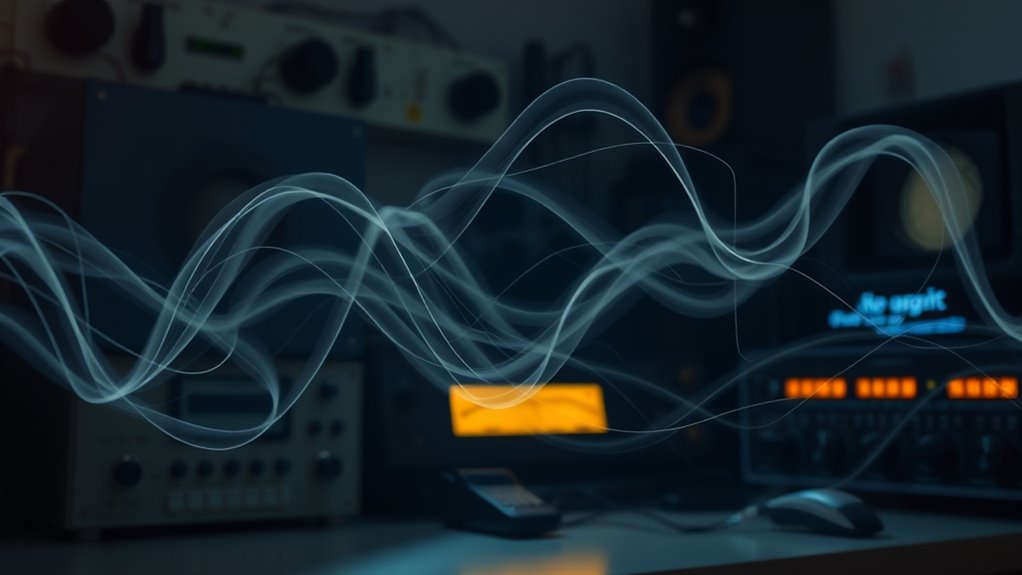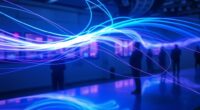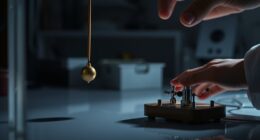EVP and static noise often seem like spirits trying to communicate, but science explains their origins through sound perception, environmental factors, and psychological biases. Static masks background sounds and might carry faint signals, while our brains are prone to illusions and pareidolia, filling in ambiguous noises as voices. Understanding how equipment and environmental noise influence recordings helps clarify their true nature. Keep exploring, and you’ll discover more about the fascinating science behind spirit voices.
Key Takeaways
- EVP recordings often contain static and white noise, which can both obscure and facilitate the detection of faint spirit voices.
- Static acts as a medium that may carry or amplify anomalous sounds, influencing the perception of spirit communication.
- Human auditory perception, including illusions and biases, plays a significant role in interpreting ambiguous sounds as spirit voices.
- Scientific analysis involves examining frequency patterns, artifacts, and environmental interference to evaluate EVP authenticity.
- Skepticism emphasizes ruling out technological artifacts and environmental noise, advocating for objective methods in spirit voice research.
Understanding Electronic Voice Phenomena (EVP)

Electronic Voice Phenomena, or EVP, refers to the sounds or voices that people believe are produced by spirits or other supernatural entities. Many paranormal theories suggest EVP is a way for spirits to communicate with the living, often captured on audio recordings. Cultural interpretations vary widely; some see EVP as evidence of an afterlife, while others view it as psychological phenomena or random noise. In some traditions, EVP is considered a spiritual gift or a method for contacting ancestors. Skeptics argue that these voices are simply pareidolia—an attempt by the brain to find patterns in random sounds. Understanding EVP involves exploring these diverse perspectives, which shape how people interpret what they hear in recordings, blending scientific inquiry with cultural and spiritual beliefs. Additionally, some believe that eco-friendly crafting techniques can be incorporated into creating tools or equipment for recording and analyzing EVP, merging sustainability with paranormal research. Recognizing the scientific limitations in EVP research is crucial for maintaining a balanced perspective on its potential significance.
The Role of Static and White Noise in Audio Recordings

White noise often acts as a masking layer in recordings, making subtle voices more noticeable. Static can serve as a medium that potentially carries or amplifies signals, whether intentional or not. Understanding how these sounds influence audio helps you evaluate the authenticity of EVP or other phenomena. High refresh rates in projectors are crucial for smooth motion rendering, which can be analogous to how consistent static or noise patterns impact audio perception. Additionally, the biodiversity in ecosystems demonstrates how diverse elements can work together to produce complex, meaningful signals that may be relevant when analyzing audio phenomena. The exfoliating properties of glycolic acid in skincare demonstrate how deep cleansing can reveal clearer results in a short period.
White Noise’s Effectiveness
Although static and white noise are often dismissed as mere background sounds, they can markedly improve audio recordings by masking disruptive noises and providing a steady auditory environment. White noise helps enhance signal clarity, making faint voices more detectable. Its consistent pattern reduces distractions, allowing subtle sounds to stand out. To understand its impact better, consider this table:
| Benefit | Explanation | Example |
|---|---|---|
| Noise Masking | Covers unwanted background sounds | Street noise masking EVP |
| Signal Clarity | Improves detection of faint voices | Spirit communication clarity |
| Consistent Environment | Stabilizes audio for better analysis | Reduces fluctuations in recordings |
| Focus Enhancement | Keeps the listener’s focus on desired sounds | EVP listening sessions |
White noise is a powerful tool for clarifying EVP recordings and revealing hidden messages. Additionally, sound consistency plays a crucial role in maintaining the integrity of the recording environment. Proper use of audio stabilization techniques can further enhance the reliability of captured voices and minimize interference. Furthermore, understanding the role of static in creating a stable recording background can significantly improve the chances of capturing clear spirit voices. Recognizing the importance of passive voice detection can also help researchers produce more precise and effective recordings by ensuring clarity in the spoken words. Moreover, maintaining a controlled environment with background noise management can greatly improve overall recording quality.
Static as Signal Medium
Static and white noise serve not just as background sounds but as active mediums that carry and transmit signals in audio recordings. Static interference often appears as unpredictable disturbances, yet it can act as a conduit for spirit voices or EVP phenomena. When used intentionally, static enhances signal detection by providing a consistent, continuous backdrop that facilitates the emergence of faint or subtle sounds. This process, known as signal enhancement, relies on the idea that spirits may manipulate static interference to communicate. By carefully filtering or analyzing static-laden recordings, you increase the chance of identifying meaningful signals amid the noise. Static therefore becomes more than mere interference; it transforms into a crucial signal medium, bridging the gap between the physical and the spiritual domains. Additionally, understanding the role of static in audio recording technology can help practitioners better interpret these elusive signals. Recognizing how background noise interacts with recording equipment can further improve the accuracy of EVP detection and interpretation.
Scientific Principles Behind Sound Perception and Auditory Illusions

Your ears can detect sounds within a specific range, shaping how you perceive audio signals. Auditory illusions reveal how your brain interprets sounds, sometimes creating perceptions that aren’t actually present. Psychological factors also influence what you hear, affecting how you interpret static, voices, or ambiguous noises. Understanding sound perception helps clarify why certain auditory illusions can trick the mind into hearing things that aren’t there. Additionally, home decor elements such as wall organization and visual cues can subtly influence perception and mood, highlighting the complex interaction between environment and sensory processing. The complexity of algorithms used in auditory processing can also impact how we interpret ambiguous sounds, demonstrating the influence of technology on perception. Recognizing the role of AI in perception offers insights into how technology can simulate or influence auditory experiences.
Human Hearing Range
The human hearing range spans from approximately 20 Hz to 20,000 Hz, allowing you to perceive a wide variety of sounds. Within this range, your auditory system processes different frequencies through auditory processing, enabling you to interpret pitch, tone, and loudness. Your ears also work together to help with sound localization, so you can determine the direction and distance of a sound source. This ability relies on tiny differences in the time and intensity of sounds reaching each ear. Understanding your hearing range is vital when analyzing recordings like EVP or static, as sounds outside this range are less likely to be heard clearly. Your auditory perception shapes how you interpret the environment and detect subtle auditory cues in your surroundings.
Auditory Illusions Explained
Auditory illusions occur when the brain interprets sounds in ways that differ from their physical properties, revealing how perception is shaped by complex neural processes. These illusions highlight perceptual biases that can lead to auditory hallucinations or misinterpretations. Your brain fills in gaps or creates sounds based on prior experiences or expectations, sometimes perceiving voices or noises that aren’t there. For example, the brain might interpret random static as meaningful speech. Recognizing these illusions helps you understand that what you hear isn’t always an accurate reflection of reality. The table below illustrates common examples of auditory illusions and their underlying perceptual biases:
| Illusion Type | Perceptual Bias |
|---|---|
| Phoneme Restoration | Filling in missing sounds |
| The Shepard Tone | Expectation of rising pitch |
| McGurk Effect | Visual influence on sound |
| Auditory Pareidolia | Seeing patterns in noise |
| Auditory Hallucinations | Perception without stimulus |
Psychological Perception Factors
Understanding how sound perception works involves exploring the psychological factors that influence what you hear. Perception biases shape your interpretation of sounds, often leading you to find patterns or voices where none exist. These biases can cause your mind to fill in gaps, especially during ambiguous audio, making static or noise seem meaningful. Sensory adaptation also plays a role; when exposed to consistent sounds, your sensitivity decreases, causing you to perceive new or faint sounds more prominently. This process can create the illusion of spirit voices in EVP recordings, as your brain attempts to make sense of random noise. Recognizing these psychological factors helps you understand why your mind might interpret static as voices, emphasizing the importance of scientific awareness in evaluating audio evidence.
Equipment and Techniques Used in Spirit Voice Recordings

To capture spirit voices effectively, researchers rely on specialized equipment and techniques designed to minimize interference and enhance faint sounds. Using high-quality digital recording devices ensures clear audio capture, reducing background noise. After recording, acoustic analysis helps distinguish potential EVP from static or ambient sounds. Here are essential tools and methods:
- High-Sensitivity Digital Recorders: Capture subtle voices with minimal distortion.
- Acoustic Analysis Software: Analyze frequencies and patterns to identify anomalies.
- Shielded Microphones: Prevent electromagnetic interference that can obscure faint sounds.
These techniques improve the chances of detecting genuine spirit voices while providing data that can be scrutinized scientifically, making EVP recordings more reliable and meaningful.
Analyzing the Validity of EVP and Static Evidence

Evaluating the validity of EVP and static evidence requires a careful and systematic approach, as distinguishing genuine spirit voices from background noise or equipment artifacts can be challenging. Paranormal skepticism urges you to question whether these sounds truly originate from spirits or are simply misinterpretations of static. Cultural interpretations also influence how you perceive these recordings; different beliefs may shape whether you see them as meaningful or coincidental. To assess validity, you should analyze the audio’s consistency, look for contextual clues, and consider alternative explanations like interference or pareidolia. Remember, skepticism isn’t dismissing the possibility but ensuring you rely on objective evaluation rather than emotional or cultural biases. This balanced approach helps you better understand the complexities behind EVP and static recordings.
Recent Research and Future Directions in Spirit Communication Technologies

Recent advancements in spirit communication technologies have opened new avenues for exploring the paranormal, driven by innovative research and emerging scientific approaches. Researchers now explore how the mind-body connection influences EVP recordings, suggesting consciousness alteration may enable contact beyond ordinary perception. Future directions include:
- Using neurofeedback and brainwave monitoring to better understand how altered states of consciousness affect spirit communication.
- Developing devices that harness electromagnetic fields to enhance the sensitivity of EVP recordings.
- Integrating virtual reality to simulate environments that facilitate consciousness alteration, potentially revealing new ways to interact with spirits.
These approaches aim to bridge science and spirituality, advancing our understanding of the mind-body connection and opening new possibilities for deciphering EVP signals.
Frequently Asked Questions
Can EVP Recordings Be Intentionally Manipulated or Fabricated?
You might wonder if EVP recordings can be intentionally manipulated or fabricated. Sadly, audio fakery and editing techniques make it possible to create convincing false voices, which can deceive listeners. Skilled manipulators use these methods to alter recordings, making them sound authentic. So, when evaluating EVP, always consider the possibility of editing techniques and audio fakery, and look for signs that might reveal a recording’s true origin.
How Do Cultural Beliefs Influence Interpretations of Spirit Voices?
Imagine a kaleidoscope of beliefs shaping how you hear whispers from beyond. Your cultural biases and interpretive frameworks color your perception of spirit voices, turning ambiguous sounds into meaningful messages. These influences act like filters, guiding your understanding and sometimes creating illusions. So, your background doesn’t just shape what you believe— it actively influences how you interpret these mysterious voices, blending perception with cultural storytelling.
Are There Psychological Factors Affecting Perception of EVP Sounds?
You might find that psychological factors like auditory illusions influence how you perceive EVP sounds. Your brain tends to fill in gaps or interpret ambiguous sounds based on expectations, leading to confirmation bias. This means you’re more likely to hear what you want or expect, rather than an actual spirit voice. Recognizing these biases helps you understand that perception isn’t always objective, and that your mind plays a big role in what you hear.
What Ethical Considerations Exist in Recording and Sharing EVP Evidence?
When recording and sharing EVP evidence, you need to consider ethical issues like consent and privacy. You should always obtain permission from anyone involved before capturing or sharing recordings, respecting their right to privacy. Avoid posting recordings that could embarrass or harm others without their consent. By being transparent and respectful, you ensure your practices remain ethical and maintain trust with those involved or affected by your recordings.
How Do Different Environments Impact the Quality of Spirit Voice Recordings?
Like a vintage radio tuned to the right station, your environment shapes spirit voice recordings. Ambient noise can obscure or distort voices, so choose quiet settings. Proper equipment placement—away from electronics and reflective surfaces—ensures clearer captures. You’ll find that calmer, less cluttered spaces enhance your chances of recording authentic spirit voices, letting you connect more deeply with the unseen world.
Conclusion
You might wonder if EVP truly captures spirits or if static tricks your mind. While some argue that auditory illusions or subconscious perception explain the phenomena, others believe there’s real evidence beyond chance. Scientific research suggests our brains are wired to find meaning in noise, but whether that proves spirit communication remains uncertain. Ultimately, the truth may lie in developing better technology and understanding human perception—keeping the mystery alive while seeking solid proof.









